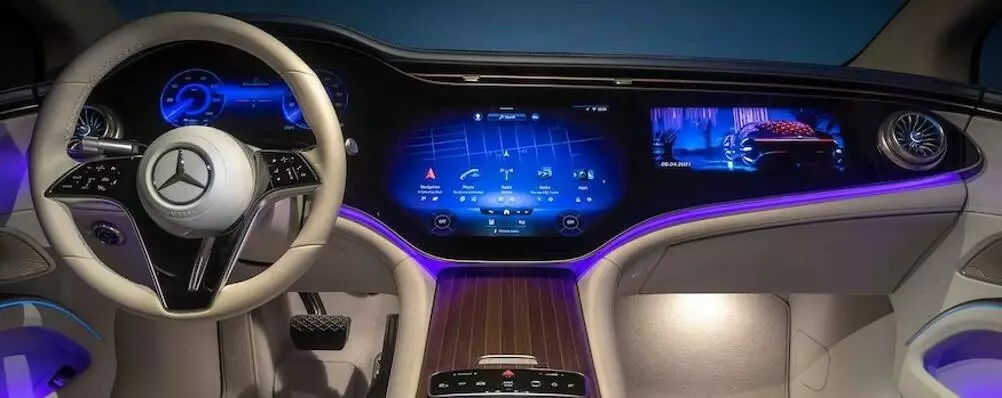Since the debut of the first digital display in an automobile (the 1976 Aston Martin), the amount of space allocated for vehicle displays has increased dramatically. The 2012 Tesla included the first automotive touch-screen display. Measuring 17 inches diagonally, it marked the onset of a new era of larger display panels within vehicles.
In recent years, the industry has rapidly advanced in the size and number of displays in the cockpit, including instrument center stack, cluster displays, and passenger infotainment displays. This article delves into the transformation of automotive dashboards with the emergence of pillar-to-pillar displays.
In 2021, suppliers and automakers showcased novel display designs that span the entire width of the dashboard, from one A-pillar to the other. These new pillar-to-pillar (P2P) displays can exceed a meter in width and have already been integrated into numerous vehicles on the market, with plans for inclusion in more models within the next two years.
The P2P display market (valued at $36 million in 2022) is projected to increase by 46.2% compound annual growth rate (CAGR) through 2032, reaching $1.65 billion.1
P2P displays deliver an "immersive" driver experience. These dashboards typically incorporate multiple component displays beneath a sheet of touchscreen glass. Only a few P2P displays have been launched (in the 2022 and 2023 Mercedes-Benz EQS and the 2023 Cadillac Celestiq).

Mercedes-Benz 2022 EQS 56” “Hyperscreen” includes an LCD instrument cluster display and two flexible OLED screens for center-stack and passenger displays, with all panels bonded under a single sheet of cover glass. (Image ©Mercedes-Benz)
The EQS "hyperscreen" dashboard, manufactured by LG Displays, integrates an LCD instrument cluster display alongside two flexible OLED screens for center-stack and passenger displays. Additional P2P displays have been announced for 2024, 2025, and 2026 vehicle models from various manufacturers, including Lincoln, Cadillac, and Afeela. BMW is pursuing a different route by announcing a panoramic (full-width) head-up display (HUD) in a 2025 model.
Ensuring the Quality of P2P Displays
Due to their configuration, size, and unique features, P2P displays provide some quality challenges that extend beyond the standard automotive display testing conducted for flat-panel and standard-size displays. A notable challenge in the measurement process is the wide aspect ratio of P2P displays.
An additional challenge is the curvature of the displays, which spans from one end to the other. While the quality and uniformity of each component display remain subject to standard testing, P2P introduces a new requirement: measuring the consistency across displays in luminance and chromaticity and ensuring white point balance.
Some P2P displays, along with larger and curved display configurations found in numerous vehicles, utilize OLED technology because of its visual quality and flexibility. However, OLED displays are emissive and require meticulous testing to ensure uniformity. Typically, a high-resolution imaging photometer or colorimeter measures the pixels and subpixels. An adjustment factor can then be computed and applied to rectify (demura) the display.
References and Further Reading
- "Surging OLED Display Industry to Set Stage for Pillar to Pillar Display Market Growth, Predicts Fact.MR." Fact.MR press release, October 13, 2022.

This information has been sourced, reviewed and adapted from materials provided by Radiant Vision Systems.
For more information on this source, please visit Radiant Vision Systems.